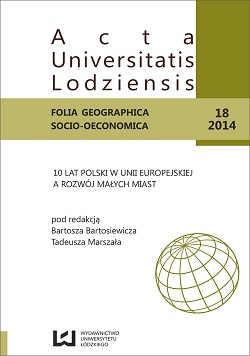Effectiveness of the transportation network in Poland developed within the 2007–2013 EU infrastructure development framework
DOI:
https://doi.org/10.18778/1508-1117.18.10Keywords:
transport network, transport accessibility, structure of transport systemAbstract
The paper examines the efficiency of the road transportation network in Poland, developed with the use of EU funds. The examined infrastructure investments increased the overall efficiency of the national transportation network, but in the process, they also increased the differences/inequalities in the level of spatial accessibility of various areas. It has been proved that smaller road infrastructure developments at a subregional level would have led to greater efficiencies in the overall efficiency of the national network.References
Barber M.J., Scherngell T., 2013, Is the European R & D Network Homogeneous? Distinguishing Relevant Network Communities Using Graph Theoretic and Spatial Interaction Modelling Approaches, „Regional Studies”, 8, s. 1283–1298.
Google Scholar
DOI: https://doi.org/10.1080/00343404.2011.622745
Bowman J.L., Ben-Akiva M.E., 2001, Activity-based disaggregate travel demand model system with activity Schedule, „Transportation Research”, 35, część A, s. 1–28.
Google Scholar
DOI: https://doi.org/10.1016/S0965-8564(99)00043-9
Brenner T., Schlump Ch., 2011, Policy Measures and their Effects in the Different Phases of the Cluster Life Cycle, „Regional Studies”, 10, s. 1363–1386.
Google Scholar
DOI: https://doi.org/10.1080/00343404.2010.529116
Brooks C.E.P., 1949, Metody stastystyczne w klimatologii, „Przegląd Meteorologiczny”, 1/49, Warszawa.
Google Scholar
Caliński T., Dyczkowski A., Kaczmarek Z., 1976, Testowanie hipotez w wielozmianowej analizie wariancji i kowariancji, „Roczniki Akademii Rolniczej”, Poznań, s. 77–114.
Google Scholar
DOI: https://doi.org/10.1080/04597237608460399
De Almeida E.S., Haddad E.A., Hewings G.J.D., 2010, Transport – Regional Equity Issue Revisited, „Regional Studies”, 10, s. 1387–1400
Google Scholar
DOI: https://doi.org/10.1080/00343400601056847
Harrigan F., McGregor P.G., 1989, Neoclassical and Keynesian perspectives on the regional macro-economi: a computable general equilibrium approach, „Regional Studies”, 29, s. 555–573.
Google Scholar
DOI: https://doi.org/10.1111/j.1467-9787.1989.tb01244.x
Healy A., Morgan K., 2012, Spaces of Innovation: Learning, Proximity and the Ecological Turn, „Regional Studies”, 8, s. 1041–1054.
Google Scholar
DOI: https://doi.org/10.1080/00343404.2012.672725
Iwaszko-Niziałkowska K., 1994, Sferyczna metoda oceny sieci komunikacyjnej w analizach układów przestrzennych, [w:] Bagiński E. (red.), Planowanie przestrzenne. Zarys metod i technik badawczych, Wydawnictwo Politechniki Wrocławskiej, Wrocław, s. 67–80.
Google Scholar
Iwaszko-Niziałkowska K., 2010, Powiązania funkcjonalne i relacje z miastem; Migracje, [w:] Modele rozwoju dla terenów urbanizujących się w obrębie wielofunkcyjnych terenów wiejskich w regionie, Analizy, badania i prognozy na rzecz Strategii Rozwoju Województwa Dolnośląskiego, t. 5, Wrocław, s. 111–196.
Google Scholar
Iwaszko-Niziałkowska K., 2012, Sieć transportowa – Geografia a szanse rozwoju regionów, [w:] Ilnicki D., Janec K. (red.), Badania regionalnych i lokalnych struktur przestrzennych, Rozprawy Naukowe Instytutu Geografii i Rozwoju Regionalnego Uniwersytetu Wrocławskiego, 29, Wrocław, s. 101–110.
Google Scholar
Koncepcja Przestrzennego Zagospodarowania Kraju 2030, http://www.mir.gov.pl/rozwoj_regionalny/Polityka_przestrzenna/KPZK/Strony/Koncepcja_Przestrzennego_Zagospodarowania_Kraju.aspx (dostęp: 19.09.2013).
Google Scholar
Lee Y., Hickman M., Washington S., 2007, Household type and structure, time-use pattern, and trip – chaining behaviour, „Transportation Research”, 41, część A, s. 1004–1020.
Google Scholar
DOI: https://doi.org/10.1016/j.tra.2007.06.007
Olesiuk A., 2009, Konkurencyjność regionów a parki technologiczne i klastry przemysłowe, Oficyna Wydawnicza Branta, Bydgoszcz–Warszawa, s. 79–91.
Google Scholar
Parr J.B., 2004, The policentric urban region: a closer inspection, „Regional Studies”, 38, s. 231–240.
Google Scholar
DOI: https://doi.org/10.1080/003434042000211114
Parysek J., 1982, Modele klasyfikacji w geografii, „Seria Geografia”, 31, Poznań
Google Scholar
Porter M.E., 2000, Location, competition, and economic development: Local clusters in a global economy, „Economic Development Quarterly”, 14, s. 15–34.
Google Scholar
DOI: https://doi.org/10.1177/089124240001400105
Romer P.M., 1990, Endogenous technological change, „Journal of Political Economy”, 98, s. 71–102.
Google Scholar
DOI: https://doi.org/10.1086/261725
Strategia Rozwoju Transportu do 2020 roku (z perspektywą do 2030 roku), http://www.mir.gov.pl/Transport/Zrownowazony_transport/SRT/Documents/Strategia_Rozwoju_Transportu_do_2020_roku.pdf (dostęp: 14.04.2013).
Google Scholar
Wilson R.J., 1998, Wprowadzenie do teorii grafów, (tłum. W. Guzicki), PWN, Warszawa
Google Scholar
Zipser T. i in., 1980, Analiza i ocena alternatywnych modeli docelowych systemu osadniczego, zagadnienia projekcji przestrzeni społeczno-ekonomicznej, Etap III, Raport Instytutu Architektury i Urbanistyki Politechniki Wrocławskiej, Wrocław.
Google Scholar
Downloads
Published
How to Cite
Issue
Section
License

This work is licensed under a Creative Commons Attribution-NonCommercial-NoDerivatives 4.0 International License.








